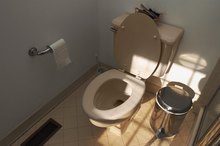Bladder Symptoms From Shingles
**According to Richard J. Whitely, M.D., professor at the University of Alabama School of Medicine, writing in the 2008 edition of “Harrison’s Principles of Internal Medicine,” shingles strikes 1.2 million Americans each year 1. The disease results when varicella-zoster, the virus that causes chicken pox, reawakens in sensory nerve roots. Shingles usually involves the area from spinal vertebrae T3 through L3, ranging from the lower lumbar to lower thoracic spine. When the lower, sacral spinal cord is involved, bladder symptoms from shingles result.
If you are experiencing serious medical symptoms, seek emergency treatment immediately.
Urinary Frequency
A 2002 study in the “Archives of Physical Medicine and Rehabilitation” describes the direct invasion of the varicella-zoster virus into the walls of the bladder of 12 of 17 patients with shingles-related bladder problems 3. The resulting inflammation of the bladder walls, known as cystitis, triggers a frequent need to urinate. The amount of urine produced is out of proportion to the urge. Urine may be pink-tinged or accompanied by feathery strands of red blood, reflecting irritation within the bladder wall. Although frequency is also a sign of a urinary tract infection, in the case of bladder problems due to zoster, urine cultures will be negative.
- A 2002 study in the “Archives of Physical Medicine and Rehabilitation” describes the direct invasion of the varicella-zoster virus into the walls of the bladder of 12 of 17 patients with shingles-related bladder problems 3.
- The resulting inflammation of the bladder walls, known as cystitis, triggers a frequent need to urinate.
Urinary Retention
How Do Shingles Affect the Bladder?
Learn More
In some cases, the varicella-zoster virus travels from sensory nerve roots to motor nerve roots. Normally, the bladder’s detrusor muscle contracts when it is stretched. As the bladder fills, the muscle contracts more and more often, triggering the urge to urinate. In some people with shingles, the varicella-zoster virus infects the nerves that supply the detrusor muscle, so that it no longer contracts, rendering the patient unable to void urine. Patients complain of pain and abdominal distention, in addition to inability to urinate. Immediate catheterization, according to a 2004 report in the “Emergency Medicine Journal,” is required to prevent bladder rupture and scarring of the kidneys 2.
- In some cases, the varicella-zoster virus travels from sensory nerve roots to motor nerve roots.
- Immediate catheterization, according to a 2004 report in the “Emergency Medicine Journal,” is required to prevent bladder rupture and scarring of the kidneys 2.
Urinary Incontinence
When shingles strikes the spinal cord itself, inflammation disrupts communication between the brain and the bladder, decreasing voluntary control over the bladder. The result is a condition called neurogenic bladder 4. Patients with neurogenic bladder complain that they can’t delay the urge to urinate in time to reach appropriate facilities 4. Fortunately, in most cases, voluntary control over the bladder is weakened, but not absent. So, most patients leak small amounts of urine, rather than the full contents of the bladder. However, getting the bathroom quickly remains essential. Wearing absorbent undergarments and regularly taking time to urinate can help reduce embarrassment due to incontinence until shingles subsides.
- When shingles strikes the spinal cord itself, inflammation disrupts communication between the brain and the bladder, decreasing voluntary control over the bladder.
- So, most patients leak small amounts of urine, rather than the full contents of the bladder.
Related Articles
References
- "Harrison's Principles of Internal Medicine, 23rd Edition;" A.S. Fauci et al.; 2008
- “Journal of Emergency Medicine;” Acute Urinary Retention Attributable to Sacral Herpes Zoster; J. Acheson and D. Mudd, Nov. 2004
- “Archives of Physical Medicine and Rehabilitation;” Herpes Zoster–Associated Voiding Dysfunction:
- MedlinePlus: Neurogenic Bladder
- Andersson KE. Potential Future Pharmacological Treatment of Bladder Dysfunction. Basic Clin Pharmacol Toxicol. 2016 Oct;119 Suppl 3:75-85. doi: 10.1111/bcpt.12577. Epub 2016 Apr 6.
- Stampas A, Korupolu R, Zhu L, Smith CP, Gustafson K. Safety, Feasibility, and Efficacy of Transcutaneous Tibial Nerve Stimulation in Acute Spinal Cord Injury Neurogenic Bladder: A Randomized Control Pilot Trial. Neuromodulation. 2018 Oct 3. doi: 10.1111/ner.12855. [Epub ahead of print]
Writer Bio
Heather Gloria began writing professionally in 1990. Her work has appeared in several professional and peer-reviewed publications including "Nutrition in Clinical Practice." Gloria earned both a Bachelor of Science in food science and human nutrition from the University of Illinois. She also maintains the "registered dietitian" credential and her professional interests include therapeutic nutrition, preventive medicine and women's health.









